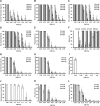A Novel In Vivo Model to Study Impaired Tissue Regeneration Mediated by Cigarette Smoke
- PMID: 30026555
- PMCID: PMC6053433
- DOI: 10.1038/s41598-018-28687-1
A Novel In Vivo Model to Study Impaired Tissue Regeneration Mediated by Cigarette Smoke
Abstract
Cigarette smoke is associated with several pathologies including chronic respiratory diseases and cancer. In addition, exposure to cigarette smoke is correlated with impaired wound healing, where a significant decrease in the regenerative capacity of smokers is well documented and broadly considered a negative risk factor after trauma or surgery. So far, some in vitro and in vivo models have been described to study how exposure to cigarette smoke diminishes the regenerative potential in different organisms. However, although useful, many of these models are difficult and expensive to implement and do not allow high-throughput screening approaches. In order to establish a reliable and accessible model, we have evaluated the effects of cigarette smoke extract (CSE) on zebrafish development and regeneration. In this work, zebrafish embryos and larvae were exposed to low doses of aqueous CSE showing severe developmental abnormalities in a dose-dependent manner. Furthermore, when adult zebrafish were subjected to caudal fin amputation, we observed a significant decrease in the regenerative capacity of animals exposed to CSE. The effect was exacerbated in male and aged fish compared to female or young organisms. The establishment of a zebrafish model to assess the consequences of cigarette smoke and its effects on animal physiology could provide a new tool to study the underlying mechanisms involved in impaired tissue regeneration, and aid the development of novel approaches to treat complications associated with cigarette smoke toxicity.
Conflict of interest statement
The authors declare no competing interests.
Figures






Similar articles
-
Exposure to the gut microbiota from cigarette smoke-exposed mice exacerbates cigarette smoke extract-induced inflammation in zebrafish larvae.Curr Res Immunol. 2021 Dec 6;2:229-236. doi: 10.1016/j.crimmu.2021.12.001. eCollection 2021. Curr Res Immunol. 2021. PMID: 35492390 Free PMC article.
-
A Reliable Preclinical Model to Study the Impact of Cigarette Smoke in Development and Disease.Curr Protoc Toxicol. 2019 Jun;80(1):e78. doi: 10.1002/cptx.78. Epub 2019 May 6. Curr Protoc Toxicol. 2019. PMID: 31058471
-
Outcomes of developmental exposure to total particulate matter from cigarette smoke in zebrafish (Danio rerio).Neurotoxicology. 2018 Sep;68:101-114. doi: 10.1016/j.neuro.2018.07.003. Epub 2018 Jul 17. Neurotoxicology. 2018. PMID: 30026038
-
Systemic treatment with cigarette smoke extract affects zebrafish visual behaviour, intraocular vasculature morphology and outer segment phagocytosis.Open Res Eur. 2023 Nov 23;3:48. doi: 10.12688/openreseurope.15491.2. eCollection 2023. Open Res Eur. 2023. PMID: 38283058 Free PMC article.
-
Cigarette smoke increases pro-inflammatory markers and inhibits osteogenic differentiation in experimental exposure model.Acta Biomater. 2018 Aug;76:308-318. doi: 10.1016/j.actbio.2018.06.018. Epub 2018 Jun 12. Acta Biomater. 2018. PMID: 29902595
Cited by
-
Exposure to the gut microbiota from cigarette smoke-exposed mice exacerbates cigarette smoke extract-induced inflammation in zebrafish larvae.Curr Res Immunol. 2021 Dec 6;2:229-236. doi: 10.1016/j.crimmu.2021.12.001. eCollection 2021. Curr Res Immunol. 2021. PMID: 35492390 Free PMC article.
-
Development of a Novel Perfusable Solution for ex vivo Preservation: Towards Photosynthetic Oxygenation for Organ Transplantation.Front Bioeng Biotechnol. 2021 Dec 15;9:796157. doi: 10.3389/fbioe.2021.796157. eCollection 2021. Front Bioeng Biotechnol. 2021. PMID: 34976984 Free PMC article.
References
-
- World Health Organization. WHO report on the global tobacco epidemic, 2011: warning about the dangers of tobacco. Geneva, Switzerland http://www.who.int/tobacco/global_report/2011/en/ (2011).
-
- World Health Organization. WHO global report on trends in prevalence of tobacco smoking 2000–2025. Geneva, Switzerland http://www.who.int/tobacco/publications/surveillance/reportontrendstobac... (2015).
Publication types
MeSH terms
Substances
LinkOut - more resources
Full Text Sources
Other Literature Sources
Molecular Biology Databases

